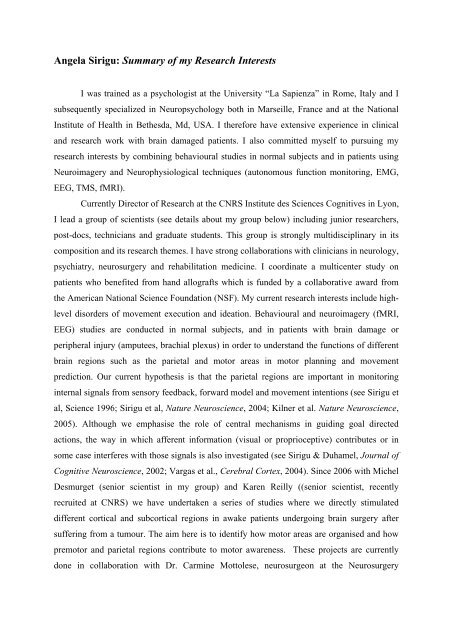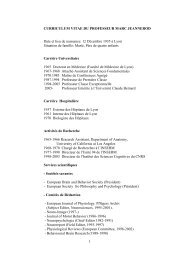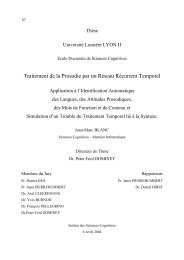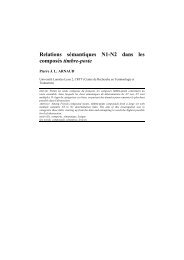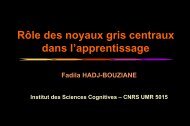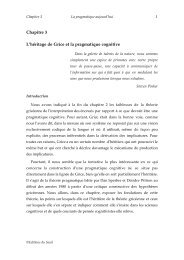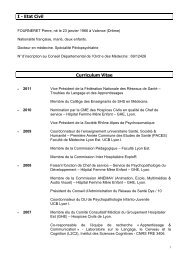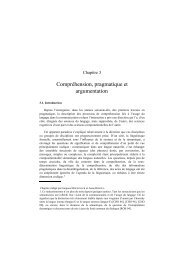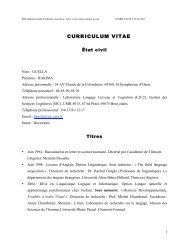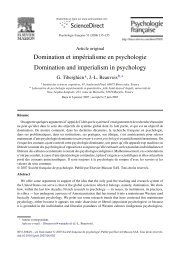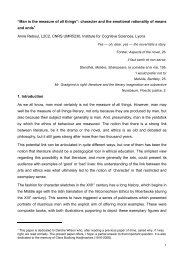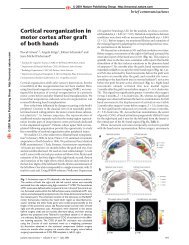curriculum vitae - CNC - Centre de Neurosciences Cognitives - CNRS
curriculum vitae - CNC - Centre de Neurosciences Cognitives - CNRS
curriculum vitae - CNC - Centre de Neurosciences Cognitives - CNRS
- No tags were found...
You also want an ePaper? Increase the reach of your titles
YUMPU automatically turns print PDFs into web optimized ePapers that Google loves.
Angela Sirigu: Summary of my Research Interests<br />
I was trained as a psychologist at the University “La Sapienza” in Rome, Italy and I<br />
subsequently specialized in Neuropsychology both in Marseille, France and at the National<br />
Institute of Health in Bethesda, Md, USA. I therefore have extensive experience in clinical<br />
and research work with brain damaged patients. I also committed myself to pursuing my<br />
research interests by combining behavioural studies in normal subjects and in patients using<br />
Neuroimagery and Neurophysiological techniques (autonomous function monitoring, EMG,<br />
EEG, TMS, fMRI).<br />
Currently Director of Research at the <strong>CNRS</strong> Institute <strong>de</strong>s Sciences <strong>Cognitives</strong> in Lyon,<br />
I lead a group of scientists (see <strong>de</strong>tails about my group below) including junior researchers,<br />
post-docs, technicians and graduate stu<strong>de</strong>nts. This group is strongly multidisciplinary in its<br />
composition and its research themes. I have strong collaborations with clinicians in neurology,<br />
psychiatry, neurosurgery and rehabilitation medicine. I coordinate a multicenter study on<br />
patients who benefited from hand allografts which is fun<strong>de</strong>d by a collaborative award from<br />
the American National Science Foundation (NSF). My current research interests inclu<strong>de</strong> highlevel<br />
disor<strong>de</strong>rs of movement execution and i<strong>de</strong>ation. Behavioural and neuroimagery (fMRI,<br />
EEG) studies are conducted in normal subjects, and in patients with brain damage or<br />
peripheral injury (amputees, brachial plexus) in or<strong>de</strong>r to un<strong>de</strong>rstand the functions of different<br />
brain regions such as the parietal and motor areas in motor planning and movement<br />
prediction. Our current hypothesis is that the parietal regions are important in monitoring<br />
internal signals from sensory feedback, forward mo<strong>de</strong>l and movement intentions (see Sirigu et<br />
al, Science 1996; Sirigu et al, Nature Neuroscience, 2004; Kilner et al. Nature Neuroscience,<br />
2005). Although we emphasise the role of central mechanisms in guiding goal directed<br />
actions, the way in which afferent information (visual or proprioceptive) contributes or in<br />
some case interferes with those signals is also investigated (see Sirigu & Duhamel, Journal of<br />
Cognitive Neuroscience, 2002; Vargas et al., Cerebral Cortex, 2004). Since 2006 with Michel<br />
Desmurget (senior scientist in my group) and Karen Reilly ((senior scientist, recently<br />
recruited at <strong>CNRS</strong>) we have un<strong>de</strong>rtaken a series of studies where we directly stimulated<br />
different cortical and subcortical regions in awake patients un<strong>de</strong>rgoing brain surgery after<br />
suffering from a tumour. The aim here is to i<strong>de</strong>ntify how motor areas are organised and how<br />
premotor and parietal regions contribute to motor awareness. These projects are currently<br />
done in collaboration with Dr. Carmine Mottolese, neurosurgeon at the Neurosurgery


